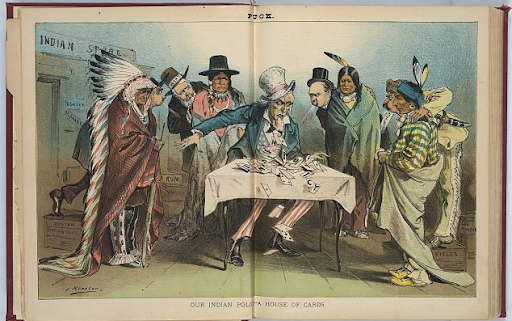Overview
U.S. Federal Indian Policies during the 19th-20th Century

Author: Stephanie Lumsden, PhD (Hupa)
Lesson partner: Rebecca Lowry, Humboldt County Office of Education
Grades: 9-12
Suggested Amount of Time: 55 minutes
Curriculum Themes
- History
- Law/Government
Learning Goals
Students will:
Analyze the complex and varied outcomes of Federal Indian policies through and during in-class discussion.
Recall and summarize significant Federal Indian policies by engaging in an in-class word matching study activity.
Collaborate with classmates and evaluate Federal Indian policies.
Understand how the law is important to U.S. settler-colonialism.
Work with a partner or individually to complete an in-class activity.
Create a simple timeline that represents eras of Federal Indian law.
Unit Overview
This lesson introduces students to some of the most significant Federal Indian policies in the U.S. during the 19th and early 20th century. The lesson focuses on three eras of Federal Indian law; the removal and reservation era, the assimilation era, and the limited tribal self-rule era. This brief lesson spans 120+ years of Federal Indian law and is intended to introduce students to key concepts related to the complex legal relationship between Native American nations and the United States. The lesson consists of a lecture about the historical context of the law, a chronological timeline of the laws and policies presented, a video, and an in-class word matching activity designed to help students study the contents of the lesson.
The teacher must understand that the law is not a neutral entity for Native people nor anyone else and that the passage of time has not lessened the impact of these laws on Native peoples’ lives. While many Native people study law in order to mitigate the harms of Federal Indian policies, the law has always been a tool of settler-colonialism when wielded by the U.S. The teacher must be prepared to actively engage students in a complex and difficult discussion about the legislative function of the U.S. settler state.
Essential Questions:
Who is most detrimentally impacted by Federal Indian policies? What are some of these impacts?
How can we understand Federal Indian policies differently and interpret the law as a function of U.S. settler-colonialism?
What is at stake for Native American people in terms of Federal Indian policy?
Teacher Background
For Native American peoples in the U.S. Federal Indian law has a long and violent history that has not yet abated. During the removal and reservation era, the U.S. committed horrific acts of genocide including the infamous Trail of Tears in order to secure control over stolen Native homelands. During the assimilation era Native peoples faced even more land loss under allotment, intense poverty, and the theft of their children. Finally, during the era of limited tribal self-rule there was an opportunity for tribes to assert more political agency but those gains were limited by U.S. oversight and failure to honor fiduciary obligations made via treaty with Native nations. Since its inception Federal Indian law has been dictated by settlers' desire to appropriate Native American homelands and transform them into raw material for capitalist expansion or individual private property which in turn expanded the territorial sovereignty of the U.S. As the lesson indicates, private property is not a neutral condition of ownership in a settler state like the U.S., it is a vehicle through which individual citizens claim ownership of dispossessed Native homelands. Each new era of Federal Indian law, even those that appear to grant some recognition of tribal nations’ sovereignty, has in fact weakened tribal sovereignty by further entrenching U.S. occupation of Native homelands. The key vocabulary terms in the lesson, particularly assimilation and property, are critical to understanding the ideologies that animate Federal Indian Policy and understanding ongoing Indigenous dispossession.

